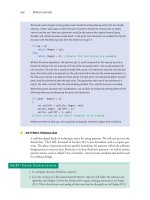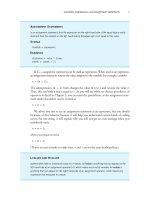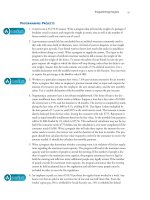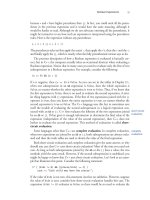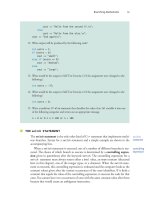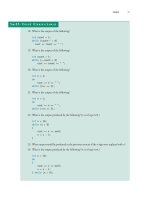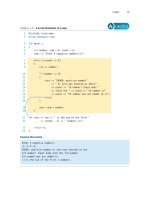Absolute C++ (4th Edition) part 21 ppsx
Bạn đang xem bản rút gọn của tài liệu. Xem và tải ngay bản đầy đủ của tài liệu tại đây (225.47 KB, 10 trang )
202 Arrays
Display 5.8 Sorting an Array
(part 2 of 3)
11 //The array elements a[0] through a[numberUsed - 1] have values.
12 //Postcondition: The values of a[0] through a[numberUsed - 1] have
13 //been rearranged so that a[0] <= a[1] <= <= a[numberUsed - 1].
14 void swapValues(int& v1, int& v2);
15 //Interchanges the values of v1 and v2.
16 int indexOfSmallest(const int a[], int startIndex, int numberUsed);
17 //Precondition: 0 <= startIndex < numberUsed. Reference array elements
18 //have values. Returns the index i such that a[i] is the smallest of the
19 //values a[startIndex], a[startIndex + 1], , a[numberUsed - 1].
20 int main( )
21 {
22 cout << "This program sorts numbers from lowest to highest.\n";
23 int sampleArray[10], numberUsed;
24 fillArray(sampleArray, 10, numberUsed);
25 sort(sampleArray, numberUsed);
26 cout << "In sorted order the numbers are:\n";
27 for (int index = 0; index < numberUsed; index++)
28 cout << sampleArray[index] << " ";
29 cout << endl;
30 return 0;
31 }
32 void fillArray(int a[], int size, int& numberUsed)
33
<
The rest of the definition of fillArray is given in Display 5.5.
>
34 void sort(int a[], int numberUsed)
35 {
36 int indexOfNextSmallest;
37 for (int index = 0; index < numberUsed - 1; index++)
38 {//Place the correct value in a[index]:
39 indexOfNextSmallest =
40 indexOfSmallest(a, index, numberUsed);
41 swapValues(a[index], a[indexOfNextSmallest]);
42 //a[0] <= a[1] <= <= a[index] are the smallest of the original array
43 //elements. The rest of the elements are in the remaining positions.
44 }
45 }
46 void swapValues(int& v1, int& v2)
47 {
48 int temp;
49 temp = v1;
50 v1 = v2;
05_CH05.fm Page 202 Wednesday, August 13, 2003 12:51 PM
Programming with Arrays 203
Self-Test Exercises
17. Write a program that will read up to ten nonnegative integers into an array called number-
Array
and then write the integers back to the screen. For this exercise you need not use any
functions. This is just a toy program and can be very minimal.
18. Write a program that will read up to ten letters into an array and write the letters back to
the screen in the reverse order. For example, if the input is
abcd.
then the output should be
dcba
Display 5.8 Sorting an Array
(part 3 of 3)
51 v2 = temp;
52 }
53
54 int indexOfSmallest(const int a[], int startIndex, int numberUsed)
55 {
56 int min = a[startIndex],
57 indexOfMin = startIndex;
58 for (int index = startIndex + 1; index < numberUsed; index++)
59 if (a[index] < min)
60 {
61 min = a[index];
62 indexOfMin = index;
63 //min is the smallest of a[startIndex] through a[index]
64 }
65 return indexOfMin;
66 }
S
AMPLE
D
IALOGUE
This program sorts numbers from lowest to highest.
Enter up to 10 nonnegative whole numbers.
Mark the end of the list with a negative number.
80 30 50 70 60 90 20 30 40 -1
In sorted order the numbers are:
20 30 30 40 50 60 70 80 90
05_CH05.fm Page 203 Wednesday, August 13, 2003 12:51 PM
204 Arrays
Use a period as a sentinel value to mark the end of the input. Call the array letterBox. For this
exercise you need not use any functions. This is just a toy program and can be very minimal.
19. Below is the declaration for an alternative version of the function
search defined in Dis-
play 5.6. In order to use this alternative version of the
search function we would need to
rewrite the program slightly, but for this exercise all you need do is write the function defi-
nition for this alternative version of
search.
bool search(const int a[], int numberUsed,
int target, int& where);
//Precondition: numberUsed is <= the declared size of the
//array a. Also, a[0] through a[numberUsed -1] have values.
//Postcondition: If target is one of the elements a[0]
//through a[numberUsed - 1], then this function returns
//true and sets the value of where so that a[where] ==
//target; otherwise, this function returns false and the
//value of where is unchanged.
Multidimensional Arrays
C++ allows you to declare arrays with more than one index. This section describes these
multidimensional arrays.
■
MULTIDIMENSIONAL ARRAY BASICS
It is sometimes useful to have an array with more than one index, and this is allowed in
C++. The following declares an array of characters called
page. The array page has two
indexes: The first index ranges from
0 to 29 and the second from 0 to 99.
char page[30][100];
The indexed variables for this array each have two indexes. For example, page[0][0],
page[15][32], and page[29][99] are three of the indexed variables for this array. Note
that each index must be enclosed in its own set of square brackets. As was true of the
one-dimensional arrays we have already seen, each indexed variable for a multidimen-
sional array is a variable of the base type.
An array may have any number of indexes, but perhaps the most common number
of indexes is two. A two-dimensional array can be visualized as a two dimensional dis-
play with the first index giving the row and the second index giving the column. For
example, the array indexed variables of the two-dimensional array
page can be visual-
ized as follows:
5.4
array
declarations
indexed
variables
05_CH05.fm Page 204 Wednesday, August 13, 2003 12:51 PM
Multidimensional Arrays 205
page[0][0], page[0][1], , page[0][99]
page[1][0], page[1][1], , page[1][99]
page[2][0], page[2][1], , page[2][99]
.
.
.
page[29][0], page[29][1], , page[29][99]
You might use the array page to store all the characters on a page of text that has thirty
lines (numbered 0 through 29) and 100 characters on each line (numbered 0 through 99).
In C++, a two-dimensional array, such as
page, is actually an array of arrays. The
array
page above is actually a one-dimensional array of size 30, whose base type is a
one-dimensional array of characters of size 100. Normally, this need not concern you,
and you can usually act as if the array
page were actually an array with two indexes
(rather than an array of arrays, which is harder to keep track of). There is, however, at
least one situation in which a two-dimensional array looks very much like an array of
arrays, namely, when you have a function with an array parameter for a two-dimensional
array, which is discussed in the next subsection.
■
MULTIDIMENSIONAL ARRAY PARAMETERS
The following declaration of a two-dimensional array actually declares a one-dimensional
array of size 30 whose base type is a one-dimensional array of characters of size 100.
char page[30][100];
M
ULTIDIMENSIONAL
A
RRAY
D
ECLARATION
S
YNTAX
Type
Array_Name
[
Size_Dim_1
][
Size_Dim_2
] [
Size_Dim_Last
];
E
XAMPLES
char page[30][100];
int matrix[2][3];
double threeDPicture[10][20][30];
An array declaration of the form shown above will define one indexed variable for each combina-
tion of array indexes. For example, the second of the above sample declarations defines the fol-
lowing six indexed variables for the array
matrix:
matrix[0][0], matrix[0][1], matrix[0][2],
matrix[1][0], matrix[1][1], matrix[1][2]
05_CH05.fm Page 205 Wednesday, August 13, 2003 12:51 PM
206 Arrays
Viewing a two-dimensional array as an array of arrays will help you to understand how
C++ handles parameters for multidimensional arrays.
For example, the following is a function that takes an array, like
page, and prints it
to the screen:
void displayPage(const char p[][100], int sizeDimension1)
{
for (int index1 = 0; index1 < sizeDimension1; index1++)
{//Printing one line:
for (int index2 = 0; index2 < 100; index2++)
cout << p[index1][index2];
cout << endl;
}
}
Notice that with a two-dimensional array parameter, the size of the first dimension
is not given, so we must include an
int parameter to give the size of this first dimen-
sion. (
As with ordinary arrays, the compiler will allow you to specify the first dimension by
placing a number within the first pair of square brackets. However, such a number is only a
comment; the compiler ignores the number.) The size of the second dimension (and all
other dimensions if there are more than two) is given after the array parameter, as
shown for the parameter
const char p[][100]
If you realize that a multidimensional array is an array of arrays, then this rule begins to
make sense. Since the two-dimensional array parameter
const char p[][100]
is a parameter for an array of arrays, the first dimension is really the index of the array
and is treated just like an array index for an ordinary, one-dimensional array. The sec-
ond dimension is part of the description of the base type, which is an array of charac-
ters of size
100.
M
ULTIDIMENSIONAL
A
RRAY
P
ARAMETERS
When a multidimensional array parameter is given in a function heading or function declaration,
the size of the first dimension is not given, but the remaining dimension sizes must be given in
square brackets. Since the first dimension size is not given, you usually need an additional
parameter of type
int that gives the size of this first dimension. Below is an example of a function
declaration with a two-dimensional array parameter
p:
void getPage(char p[][100], int sizeDimension1);
05_CH05.fm Page 206 Wednesday, August 13, 2003 12:51 PM
Multidimensional Arrays 207
Example
T
WO
-D
IMENSIONAL
G
RADING
P
ROGRAM
Display 5.9 contains a program that uses a two-dimensional array named grade to store and
then display the grade records for a small class. The class has four students, and the records
include three quizzes. Display 5.10 illustrates how the array
grade is used to store data. The first
array index is used to designate a student, and the second array index is used to designate a
quiz. Since the students and quizzes are numbered starting with 1 rather than 0, we must subtract
1 from the student number and subtract 1 from the quiz number to obtain the indexed variable
that stores a particular quiz score. For example, the score that student number 4 received on quiz
number 1 is recorded in
grade[3][0].
Our program also uses two ordinary one-dimensional arrays. The array
stAve will be used to
record the average quiz score for each of the students. For example, the program will set
stAve[0] equal to the average of the quiz scores received by student 1, stAve[1] equal to the
average of the quiz scores received by student 2, and so forth. The array
quizAve will be used to
record the average score for each quiz. For example, the program will set
quizAve[0] equal to
the average of all the student scores for quiz 1,
quizAve[1] will record the average score for quiz
2, and so forth. Display 5.10 illustrates the relationship between the arrays
grade, stAve, and
quizAve. This display shows some sample data for the array grade. These data, in turn, deter-
mine the values that the program stores in
stAve and in quizAve. Display 5.11 also shows these
values, which the program computes for
stAve and quizAve.
The complete program for filling the array
grade and then computing and displaying both the
student averages and the quiz averages is shown in Display 5.9. In that program we have declared
array dimensions as global named constants. Since the procedures are particular to this program
and could not be reused elsewhere, we have used these globally defined constants in the proce-
dure bodies, rather than having parameters for the size of the array dimensions. Since it is rou-
tine, the display does not show the code that fills the array.
Display 5.9 Two-Dimensional Array
(part 1 of 3)
1 //Reads quiz scores for each student into the two-dimensional array grade (but the input
2 //code is not shown in this display). Computes the average score for each student and
3 //the average score for each quiz. Displays the quiz scores and the averages.
4 #include <iostream>
5 #include <iomanip>
6 using namespace std;
7 const int NUMBER_STUDENTS = 4, NUMBER_QUIZZES = 3;
8 void computeStAve(const int grade[][NUMBER_QUIZZES], double stAve[]);
9 //Precondition: Global constants NUMBER_STUDENTS and NUMBER_QUIZZES
10 //are the dimensions of the array grade. Each of the indexed variables
11 //grade[stNum-1, quizNum-1] contains the score for student stNum on quiz quizNum.
12 //Postcondition: Each stAve[stNum-1] contains the average for student number stNum.
13
05_CH05.fm Page 207 Wednesday, August 13, 2003 12:51 PM
208 Arrays
Display 5.9 Two-dimensional Array
(part 2 of 3)
14 void computeQuizAve(const int grade[][NUMBER_QUIZZES], double quizAve[]);
15 //Precondition: Global constants NUMBER_STUDENTS and NUMBER_QUIZZES
16 //are the dimensions of the array grade. Each of the indexed variables
17 //grade[stNum-1, quizNum-1] contains the score for student stNum on quiz quizNum.
18 //Postcondition: Each quizAve[quizNum-1] contains the average for quiz numbered
19 //quizNum.
20 void display(const int grade[][NUMBER_QUIZZES],
21 const double stAve[], const double quizAve[]);
22 //Precondition: Global constants NUMBER_STUDENTS and NUMBER_QUIZZES are the
23 //dimensions of the array grade. Each of the indexed variables grade[stNum-1,
24 //quizNum-1] contains the score for student stNum on quiz quizNum. Each
25 //stAve[stNum-1] contains the average for student stNum. Each quizAve[quizNum-1]
26 //contains the average for quiz numbered quizNum.
27 //Postcondition: All the data in grade, stAve, and quizAve have been output.
28 int main(
)
29 {
30 int grade[NUMBER_STUDENTS][NUMBER_QUIZZES];
31 double stAve[NUMBER_STUDENTS];
32 double quizAve[NUMBER_QUIZZES];
33
34
<
The code for filling the array grade goes here, but is not shown.
>
35
36 computeStAve(grade, stAve);
37 computeQuizAve(grade, quizAve);
38 display(grade, stAve, quizAve);
39 return 0;
40 }
41 void computeStAve(const int grade[][NUMBER_QUIZZES], double stAve[])
42 {
43 for (int stNum = 1; stNum <= NUMBER_STUDENTS; stNum++)
44 {//Process one stNum:
45 double sum = 0;
46 for (int quizNum = 1; quizNum <= NUMBER_QUIZZES; quizNum++)
47 sum = sum + grade[stNum-1][quizNum-1];
48 //sum contains the sum of the quiz scores for student number stNum.
49 stAve[stNum-1] = sum/NUMBER_QUIZZES;
50 //Average for student stNum is the value of stAve[stNum-1]
51 }
52 }
53 void computeQuizAve(const int grade[][NUMBER_QUIZZES], double quizAve[])
05_CH05.fm Page 208 Wednesday, August 13, 2003 12:51 PM
Multidimensional Arrays 209
Display 5.9 Two-dimensional Array
(part 3 of 3)
54 {
55 for (int quizNum = 1; quizNum <= NUMBER_QUIZZES; quizNum++)
56 {//Process one quiz (for all students):
57 double sum = 0;
58 for (int stNum = 1; stNum <= NUMBER_STUDENTS; stNum++)
59 sum = sum + grade[stNum-1][quizNum-1];
60 //sum contains the sum of all student scores on quiz number quizNum.
61 quizAve[quizNum-1] = sum/NUMBER_STUDENTS;
62 //Average for quiz quizNum is the value of quizAve[quizNum-1]
63 }
64 }
65 void display(const int grade[][NUMBER_QUIZZES],
66 const double
stAve[], const double quizAve[])
67 {
68 cout.setf(ios::fixed);
69 cout.setf(ios::showpoint);
70 cout.precision(1);
71 cout << setw(10) << "Student"
72 << setw(5) << "Ave"
73 << setw(15) << "Quizzes\n";
74 for (int stNum = 1; stNum <= NUMBER_STUDENTS; stNum++)
75 {//Display for one stNum:
76 cout << setw(10) << stNum
77 << setw(5) << stAve[stNum-1] << " ";
78 for (int quizNum = 1; quizNum <= NUMBER_QUIZZES; quizNum++)
79 cout << setw(5) << grade[stNum-1][quizNum-1];
80 cout << endl;
81 }
82 cout << "Quiz averages = ";
83 for (int quizNum = 1; quizNum <= NUMBER_QUIZZES; quizNum++)
84 cout << setw(5) << quizAve[quizNum-1];
85 cout << endl;
86 }
S
AMPLE
D
IALOGUE
<
The dialogue for filling the array grade is not shown.
>
Student Ave Quizzes
1 10.0 10 10 10
2 1.0 2 0 1
3 7.7 8 6 9
4 7.3 8 4 10
Quiz Average = 7.0 5.0 7.5
05_CH05.fm Page 209 Wednesday, August 13, 2003 12:51 PM
210 Arrays
grade[3][1] is the
grade that student 4
received on quiz 2.
student 1
grade[0][0] grade[0][1] grade[0][2] 1
student 2
grade[1][0] grade[1][1] grade[1][2] 2
student 3
grade[2][0] garde[2][1] grade[2][2] 3
student 4
grade[3][0] grade[3][1] grade[3][2] 4
quiz 1
quiz 2
quiz 3
grade[3][2] is the
grade that student 4
received on quiz 3.
grade[3][0] is the
grade that student 4
received on quiz 1.
Display 5.10 The Two-Dimensional Array grade
quizAve[0]
quizAve[1]
quizAve[2]
Display 5.11 The Two-Dimensional Array grade
quiz 1
quiz 2
quiz 3
student 1
10 10 10 10.0 stAve[0]
student 2
2 0 1 1.0 stAve[1]
student 3
8 6 9 7.7 stAve[2]
student 4
8 4 10 7.3 stAve[3]
quizAve
7.0 5.0 7.5
05_CH05.fm Page 210 Wednesday, August 13, 2003 12:51 PM
Chapter Summary 211
Self-Test Exercises
20. What is the output produced by the following code?
int myArray[4][4], index1, index2;
for (index1 = 0; index1 < 4; index1++)
for (index2 = 0; index2 < 4; index2++)
myArray[index1][index2] = index2;
for (index1 = 0; index1 < 4; index1++)
{
for (index2 = 0; index2 < 4; index2++)
cout << myArray[index1][index2] << " ";
cout << endl;
}
21. Write code that will fill the array a (declared below) with numbers typed in at the key-
board. The numbers will be input five per line, on four lines (although your solution need
not depend on how the input numbers are divided into lines).
int a[4][5];
22. Write a function definition for a void function called echo such that the following func-
tion call will echo the input described in Self-Test Exercise 21, and will echo it in the same
format as we specified for the input (that is, four lines of five numbers per line):
echo(a, 4);
■ An array can be used to store and manipulate a collection of data that is all of the
same type.
■ The indexed variables of an array can be used just like any other variables of the base
type of the array.
■ A for loop is a good way to step through the elements of an array and perform some
program action on each indexed variable.
■ The most common programming error made when using arrays is attempting to
access a nonexistent array index. Always check the first and last iterations of a loop
that manipulates an array to make sure it does not use an index that is illegally small
or illegally large.
■ An array formal parameter is neither a call-by-value parameter nor a call-by-reference
parameter, but a new kind of parameter. An array parameter is similar to a call-by-
reference parameter in that any change that is made to the formal parameter in the
body of the function will be made to the array argument when the function is
called.
Chapter Summary
05_CH05.fm Page 211 Wednesday, August 13, 2003 12:51 PM
